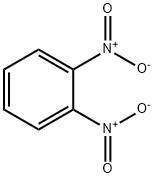디니트로 벤젠
|
|
디니트로 벤젠 속성
- 녹는점
- 116 °C
- 끓는 점
- 319 °C773 mm Hg(lit.)
- 밀도
- 1.57
- 굴절률
- 1.5650
- 인화점
- 150 °C
- 용해도
- 클로로포름: 용해성 5%, 투명, 황록색
- 색상
- 무색~황색 바늘
- 수용성
- 150 mg/L (20 ºC)
- Merck
- 14,3273
- BRN
- 642224
- 노출 한도
- NIOSH REL: TWA 1, IDLH 50; OSHA PEL: TWA 1; ACGIH TLV: TWA 0.15 ppm for all isomers (adopted).
- CAS 데이터베이스
- 528-29-0(CAS DataBase Reference)
안전
- 위험 및 안전 성명
- 위험 및 사전주의 사항 (GHS)
| 위험품 표기 | T+,N | ||
|---|---|---|---|
| 위험 카페고리 넘버 | 26/27/28-33-50/53 | ||
| 안전지침서 | 28-36/37-45-60-61-28A | ||
| 유엔번호(UN No.) | UN 3443 6.1/PG 2 | ||
| WGK 독일 | 3 | ||
| RTECS 번호 | CZ7450000 | ||
| 위험 등급 | 6.1(a) | ||
| 포장분류 | II | ||
| HS 번호 | 29042000 | ||
| 유해 물질 데이터 | 528-29-0(Hazardous Substances Data) | ||
| 독성 | IC50 (24-h) for river bacteria 1.80 mg/L (Yuan and Lang, 1997). | ||
| IDLA | 50 mg/m3 | ||
| 기존화학 물질 | KE-05-0550 |
디니트로 벤젠 C화학적 특성, 용도, 생산
화학적 성질
light yellow-brown powder용도
1,2-Dinitrobenzene was used as internal standard for analysis of the explosives, TNT, RDX, and tetryl in sea water by vapor phase chromatography with the nickel-63 electron capture detector.일반 설명
Colorless to yellow solid. Sinks and slowly mixes with water.공기와 물의 반응
Slowly mixes with water.반응 프로필
All three isomers have similar properties and may react vigorously with oxidizing materials. Their reaction with nitric acid (nitration) will lead to a mixture of trinitrobenzenes possessing high-explosive properties [Urbanski, 1967, vol. 3, p. 290]. If heat and reaction conditions of the nitration are not controlled, detonation comparable to TNT may occur [Anon., J. R. Inst. Chem., 1960, 84, p. 451]. Mixture of 1,3-dinitrobenzene with tetranitromethane was found highly explosive [Urbanski, 1964, vol. 1, 592]. 1,2-dinitrobenzene is a severe explosion hazard when shocked or exposed to heat or flame. When heated to decomposition all dinitrobenzens emit toxic fumes of nitrogen oxides [Sax, 9th ed., 1996, p. 1374].건강위험
INHALATION, INGESTION, OR SKIN ABSORPTION: Headache, vertigo and vomiting followed by exhaustion, numbness of the legs, staggering and collapse. Intense methemoglobinenia may lead to asphyxia severe enough to injure the CNS. EYES: Irritation. SKIN: Stains skin yellow.Safety Profile
Suspected carcinogen. Poison by inhalation and ingestion. Moderately toxic by sktn contact. Can cause liver, kidney, and central nervous system injury. Combustible when exposed to heat or flame; can react vigorously with oxidzing materials. A severe explosion hazard when shocked or exposed to heat or flame. It is used in bursting charges and to fiu artillery shells. Mixtures with nitric acid are highly explosive. To fight fire, use water, Co2, dry chemical. Dangerous; when heated to decomposition it emits highly toxic fumes of NO, and explodes. See also mand pDINITROBENZENE and NITRO COMPOUNDS of AROMATIC HYDROCARBONS.환경귀착
Biological. Under anaerobic and aerobic conditions using a sewage inoculum, 1,2-dinitrobenzene degraded to nitroaniline (Hallas and Alexander, 1983).Photolytic. Low et al. (1991) reported that the nitro-containing compounds (e.g., 2,4- dinitrophenol) undergo degradation by UV light in the presence of titanium dioxide yielding ammonium, carbonate, and nitrate ions. By analogy, 1,2-dinitrobenzene should degrade forming identical ions.
Chemical/Physical. Releases toxic nitrogen oxides when heated to decomposition (Sax and Lewis, 1987). 1,2-Dinitrobenzene will not hydrolyze in water (Kollig, 1993).









